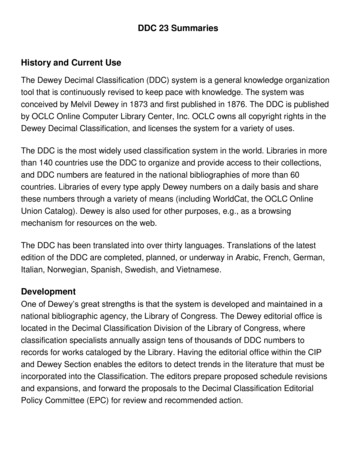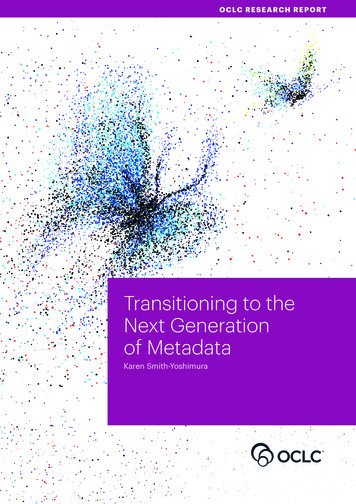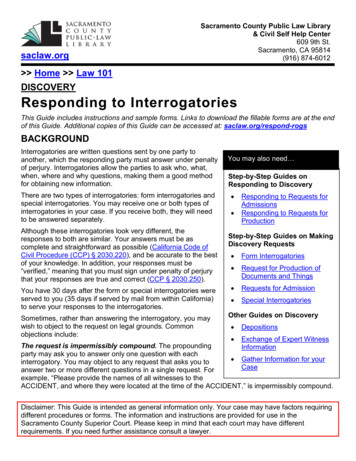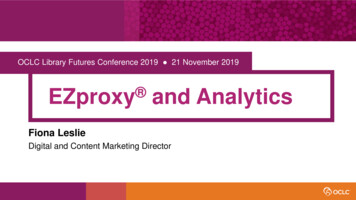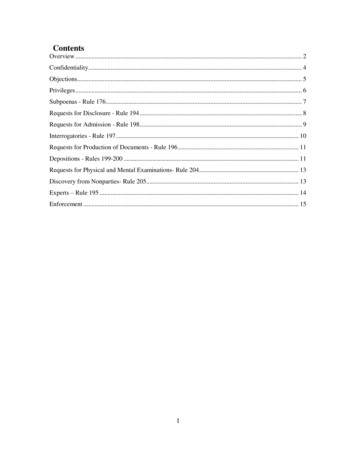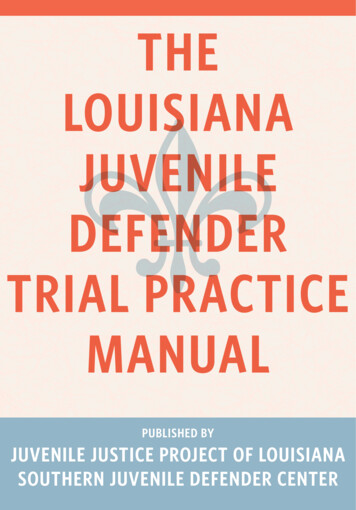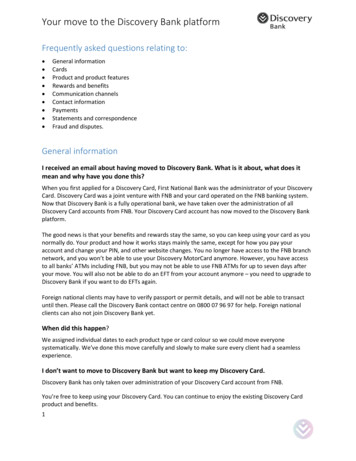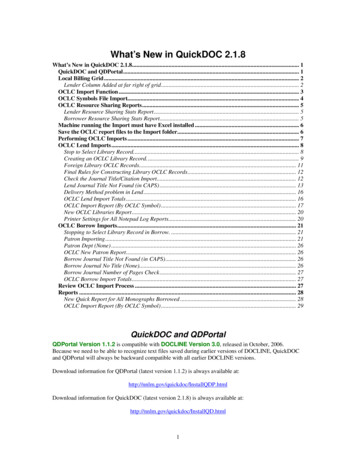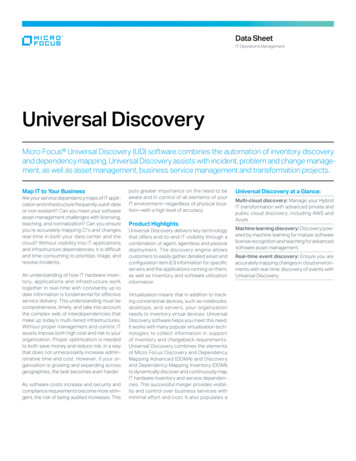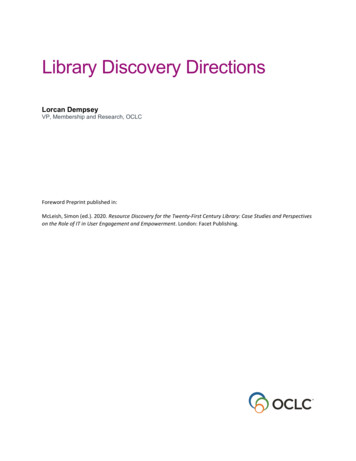
Transcription
Library Discovery DirectionsLorcan DempseyVP, Membership and Research, OCLCForeword Preprint published in:McLeish, Simon (ed.). 2020. Resource Discovery for the Twenty-First Century Library: Case Studies and Perspectiveson the Role of IT in User Engagement and Empowerment. London: Facet Publishing.
Please direct correspondence to:OCLC Researchoclcresearch@oclc.orgForeword citation:Dempsey, Lorcan 2020. Foreword to Resource Discovery for the Twenty-First Century Library: Case Studies andPerspectives on the Role of IT in User Engagement and Empowerment, xxi–xxxii. Edited by Simon McLeish. London:Facet Publishing.OCLC Research Foreword Preprint. https://doi.org/10.25333/p8j4-1411.Book citationMcLeish, Simon (ed.). 2020. Resource Discovery for the Twenty-First Century Library: Case Studies and Perspectiveson the Role of IT in User Engagement and Empowerment. London: Facet Publishing.
ContentsIntroduction. 4The Peeling Away of Discovery from the Local Collection . 5The facilitated collection and the collective collection . 5Full library discovery . 7The Peeling Away of Discovery from the Local Audience . 8The inside-out collection . 8Some Technology Directions . 9Some Service Directions . 10The evolving library consultative role . 10Discovery to fulfilment . 11The discovery layer . 11In Conclusion . 12Bibliography . 13
IntroductionThe variety of topics and perspectives represented in this collection is clear evidence of the diversifiedscope of library discovery. In only a few years the emphasis has shifted from consideration of thedevelopment of a particular library service (the evolution from catalog to metasearch to discovery layer) toa broader consideration of user behaviors and service development in a complex network ecosystem ofofferings, from both libraries and third-party providers. A full appreciation of discovery and discoverabilityin a library environment now involves thinking about much more than the discovery layer.(In writing this short piece I was interested to trace this evolution in two earlier pieces I have written aboutsimilar themes. (Dempsey, 2006; Dempsey, 2012) Considered alongside this one, the three pieces arewritten at approximately six-year intervals.)For a sense of the diversity of the current ecosystem, consider the various current roles of Wikipedia,Google Scholar, reading lists, the library discovery layer, resource guides, Scopus and Web of Science,WorldCat, GoodReads, ResearchGate and Mendeley, Arxiv and PubMed Central. These and otherresources are used by library users to find specific resources of interest to them, for serendipitousdiscovery, for exploration. They are used alongside library resources, and sometimes in combination withthem. The transition from Google Books to a library catalog via WorldCat, or the transition from GoogleScholar to a licensed article via a registered library knowledge base, or the serendipitous discovery ofspecial collections in Google or Wikipedia, are all examples of such combinations.In this environment, three broad related trends are of interest. First, “discovery often happens elsewhere.”We know that library users now search for and find materials of interest in many places. These includethe network level services that are now so much a part of our network lives (Wikipedia, Google, Amazon)and as well as more specialist resources (arXiv.org, for example). The discovered resources may bebooks or journals, or they may be software, research data, learning materials and so on. We also knowthat people may “discover” materials of interest in non-library services and then turn to the library to“locate” particular instances of those resources, whether these are on a shelf, licensed by the library, orpotentially requestable from elsewhere. So, a user who spends time on ResearchGate, say, may turn tothe library if a copy of a discovered article is not available there.Second, while the library collection may be a part of the library’s information universe, it is not necessarilycentral, nor the first used. This is a natural outcome of a shift from an environment of information scarcity(where the library acquired materials for local use and was the only place to get them) to one ofinformation abundance (where the network environment is rich in relevant resources).And third, we are observing a reconfiguration of workflows. In a print world, or a world of informationscarcity, the learner or researcher had to build their workflow around the library. In a network world, manypeople will expect library resources to fit into a user’s network workflows which may comprise multipleresources (citation management, network discovery services, and so on).These changes are important, because historically library discovery and library collections went hand inhand. However, both our sense of discovery and our sense of collections are changing in different waysin the current network environment.In this context, two important trajectories seem to me to lie just under the surface of much of thediscussion in the following papers, and perhaps to provide an integrating pattern.4 Library Discovery Directions
1. The peeling away of library discovery from the local collection.2. The peeling away of library discovery from the local audience.Collection and audience boundaries are both blurring, placing different requirements on discovery. Ofcourse, each of these has very much coevolved with changing research and learning behaviors in a richnetworked, discovery ecosystem.This means that at the same time we can see a variety of other service and technology directionsemerge, and I make notes about some salient areas in subsequent sections.In this brief foreword, I can only say a little about such directions, which can then be traced with moredetail and nuance in the contributions assembled here.The Peeling Away of Discovery from the Local CollectionThe facilitated collection and the collective collectionIn a print world of scarce resources, assembling a collection close to the user made sense. And indeed,“goodness” was associated with the size of that local collection. This model extends into the electronicworld, where resources were licensed for local use. Increasingly, we are seeing that the centrality of theacquired collection to the library service and identity is an artifact of a particular phase of librarydevelopment, which we are now moving beyond. By “acquired” I mean the collections that the library haspurchased (often in print) or has licensed (usually electronic) and makes available to a local audience.But researchers and learners inhabit a network environment rich in information and workflow resources—for research, for communication, for archiving, for social sharing, and so on. These are general purpose(github, Wikipedia) or specialized (Amazon, arXiv, PubMed Central, Google Scholar, etc.). “Localness” isno longer a determining influence in information use. The acquired library collection is now actually onlyone resource among many of potential interest.In this context, we see a progressive shift in library interests from the locally acquired just-in-casecollection to the “collection as a service,” facilitating access by researchers to resources of potentialinterest wherever they are. As indicated in this figure, a variety of services have been added successivelyover the years to the resources the libraries offer.5 Library Discovery Directions
Figure 1: Evolution of library servicesHistorically the library had a “purchased” or “owned” print collection. This was supplemented by the“borrowed” collection as libraries grouped together to share materials through inter library lending. Thenthe licensed collection emerged, first with abstracting and indexing services and then with the journalliterature itself.More recently we have seen the demand-driven collections emerge. Narrowly, this relates to demanddriven acquisition. More broadly, we will see more reliance on data-driven decision-making aroundacquisition choices. In this context, there is an interesting flip. Previously, collections drove discovery; in amore demand- or data-driven environment, discovery may drive collections.As research and scholarly network resources have proliferated, we now see greater reliance on external,freely available resources. A library may proxy access to Google Scholar, may add metadata for freeebook collections or open access collections to the discovery layer or knowledge base, and is developingresource guides based on broad user interests rather than on what is solely available in the collection.One aspect of this facilitation is the “collective collection” where collections are managed in some way ata shared level above the institution. This is becoming more common, as libraries group together forresource sharing, shared print initiatives, a shared library system, or some other group activity. In the USresource sharing consortia are common; in other countries there may be national or regional groups (e.g.,the Library Hub services in the UK, Sudoc from Abes in France, or Libraries Australia). The level of6 Library Discovery Directions
coordination may vary. As an example of strong coordination, ReCAP manages a physically consolidatedprint collection on behalf of its research library members. (This is also interesting from a discovery point ofview, as members add an index of the ReCAP shared collection to their discovery layers, which hasresulted in significantly increased use of the shared collection—it would be interesting to explore howscalable an approach this would be across more libraries.)There are now also collective collections comprising shared digital collections (such as those madeavailable by Europeana, for example), or shared scholarly materials (such as the Australian ResearchData Commons, for example).What has this meant for discovery?Well, the library interest in discovery has broadened. However, the extent of the shift may bepartly obscured by organizational issues. Discovery is in fact supported across multiple librarydivisions or specialties.So, a discovery layer may be managed to provide access to the acquired collection, and this tends to beseen still as the main “discovery” support. Typically, it will provide access to the catalog (and maybe toWorldCat or another union catalog), to licensed article data (and will work with resolver/knowledge baseinfrastructure), and maybe to unique local digital materials (from a local repository or repositories). And asnoted above, various additional freely available resources may be added. In fact, management of thediscovery layer has become more complex, as access to resource sharing groups is added, and as it issupported from a variety of metadata streams.Direct access may also be provided to Google Scholar, WorldCat, PubMed Central, Scopus or Web ofScience, and core disciplinary databases (PsychInfo, for example), among others. A knowledge basemay be configured in Google Scholar to ensure transition from that discovery environment to resourceslicensed by the library. As noted, a discovery layer may be articulated in some way with a union cataloguefor access to a collective collection of which the library is a part (as is the case with our neighbours herein Ohio, for example, who have access to the shared resource of OhioLINK alongside their localcollections).A major outcome of this shift to facilitated collections is the rapid development of resource guides, whichguide users to resources of potential interest to them, inside and outside the local collection. To meet thestrong interest in open access, services have emerged that may be integrated with a discovery layer, aknowledge base, resource sharing, or deployed as browser plugins. And new areas of interest continue toemerge, research data management and open educational resources in recent years for example, whereagain, the library may wish to provide discovery options.In this way, we can see the library is guiding users to resources in multiple ways. And, of course, asdiscussed below librarians may be advising their users on finding and using resources in a much broaderdiscovery ecosystem.Full library discoveryIn current services, a library user is usually presented with a collection search, and a range of web pagesabout other library services or expertise. The two are separated in the website experience but may notactually be separate in the user expectation of the library. If I am interested in demographics, for example,why not find a curated resource guide or the name of a subject specialist as well as relevant articles orbooks when I do a search?7 Library Discovery Directions
And, indeed, we have seen discovery environments which provide a layer over not only the collections,but also potentially over the library website, library staff and expertise, resource guides, and so on. Inother words, we are seeing approaches to “full library discovery” emerge.The steps that have been taken include a search over the website generally; over events, exhibitions orspecialist services; over people and expertise (sometimes associated with resource guides); and overresource guides (as discussed above). Indeed, in the absence of dedicated services (for events, forexample), resource guides are often used as a simple content management framework for various typesof information about the library, and not only for lists of information resources.Of course, collections are still key for libraries, but as library services continue to evolve beyond thecollection and as there is a focus on deeper engagement with user communities it makes sense fordiscovery services to represent more of what the library does and can provide.This is of interest in academic libraries and is also of special interest in public libraries where event andmeeting management are an important part of outreach.We can see some systems development alongside this. One is the use of Drupal, Blacklight and otherframeworks to deliver unified results across several resources including website, and other elements oflibrary operation. In public libraries we have seen the use of events management software, customerrelationship management systems and other systems for engagement. Bibliocommons is interesting here.OCLC’s Wise system puts community engagement at the center of its operations, rather than thecollection.We may not have thought of this as “discovery” in the past, but it is an important part of the“discoverability” of the library’s capacity and potential value. And this is increasingly important for librariesof all types.The Peeling Away of Discovery from the Local AudienceThe inside-out collectionMuch of the discussion of discovery has been about the acquired collection, the materials bought andlicensed and assembled for local use. This is an “outside in” collection – the materials originate outsidethe institution.However, in a network environment, institutions themselves are important producers of cultural andscholarly resources of potentially broad interest to different external audiences.In this context, think of the scholarly workflow. Historically, the final product of research, the book orarticle, was published and it was the main research output. However, as workflows are digital and as theyare supported by various workflow tools, there is more interest in other outputs – software, methods,preprints, research data. This is encouraged by policy mandates (at national, funder, and institutionallevels), by changing norms of science and research, by an interest in reproducibility, and so on. Researchoutputs appear across the research life cycle.A related scholarly activity involves the creation of expertise and research profiles. Institutions may havetheir own systems for this, which pull together data about researchers, including bibliographic data. Oneaim is to improve the discoverability of local faculty for various reasons. And of course, many researchersthemselves are very interested in managing reputation and visibility through Google Scholar,8 Library Discovery Directions
ResearchGate or other services. The library may advise here or encourage the use of ORCID iDs, whichagain support discoverability in the scholarly ecosystem.Or think also of special collections and archives. These tend to be assets that are unique to the institutionor are rare, which have reputational value, and where the institution may accept a preservationresponsibility as part of the broader scholarly or cultural record. There is growing interest in digitizingdistinctive materials and making them more broadly available. This is to integrate them more effectively inlocal learning and research activities. However, it is also importantly to disclose them to a wider audienceoutside the institution, or to allow them to be placed alongside related materials from elsewhere.In each of these cases, there is a growing interest in “discoverability” by an audience outside theinstitution (as well as inside). In this sense, these are “inside out” collections (Dahl, 2018). The discoverydynamic is very different. While it makes sense to make sure they are represented in local discoverysystems, it may be more important that they are effectively represented in external discovery systemsused by potential audiences. So, care may be taken that they are indexed effectively by Google, ormetadata for them may be marked up with additional links to improve chances of crawling, indexing orranking. Metadata may be provided to aggregators of cultural, scholarly or open access materials. Linksmay be added to Wikipedia. And so on.The library here has a role in improving discoverability for audiences outside the institution, to enhancereputation, to increase the impact of local scholarship and research, and to share awareness of distinctivescholarly or cultural materials.Attention here is diffuse: it has no single organizational focus within the library. It is not entirely clearhow much effort libraries are putting into this area, and this will certainly vary across types and scale oflibrary. But supporting discoverability more directly in this way clearly represents a different andimportant orientation.Some Technology DirectionsSeveral technologies and techniques are important and are discussed in later contributions. Here are someinteresting directions. Linked data. Important intellectual work has been done by libraries on describing people,subjects, works and other entities and an extensive apparatus of authority files exists. That workis now being mobilized in a new environment. Our bibliographic infrastructure is evolving towardsa more entity-based approach, as we think about modeling and exposing data about structuredentities of interest (graphs of works, authors, places, for example), rather than only shippingaround bundles of data about titles (records). Work on data modeling, entity backbones, and dataaugmentation is being carried out by multiple agencies, including national libraries, publishers,and individual libraries, as well as OCLC. This is part of a more general trend, of which Google’sknowledge graph and WikiData are important examples. As the volume and variety of linksgrows, and as those links resolve to metadata about “things,” it becomes possible to match andmerge data more easily at scale, to build greater navigation and context into interfaces, and tobuild relationships across the web. This work is at early stages but shows promise in improvingdiscovery and discoverability. Data science and machine learning. Discovery is a data intensive field and will benefit fromadvances in data science and machine learning. For example, it is likely that discovery in thejournal literature will be facilitated by programmatic analysis of bodies of literature assembled by9 Library Discovery Directions
publishers, researchers and others. The assembly of large amounts of data in this way and thecollection of transaction or “intentional” data from users mean that machine learning willincreasingly be mobilized to develop scalable approaches to extract insights. There is an interestin entity recognition, topic modelling, summarization, plagiarism detection, recommendation,ranking, personalization, and in identifying patterns that may support new findings or directions.Of course, this also raises issues about privacy, algorithmic transparency, authority, andappropriate use, and libraries are stepping up to a critical role as advocates for the interests ofusers and researchers. Presentation. When the discovery layer was introduced into libraries, there was a lot ofdiscussion of a “Google like experience” and the “simple search box.” However, not even Googledoes a “Google like experience” anymore. There is a simple search box, but a huge amount ofwork goes into presenting the results. There is no longer a single ranked flow. There is the nowfamiliar knowledge card summarizing what Google knows about an entity. It may pull out images,news items, scholarly articles or other elements for highlighted presentation. Different entities willhave different elements presented. A literary work will have book covers of various editions,various fulfilment options, maybe works in the same genre. For organizations, a map may bepresented. In some cases, a carousel of similar or related items is presented at the top of thepage. And so on. Libraries rely on a small number of suppliers for their discovery layer systems(one of which is OCLC). Some then layer different presentation environments over them (e.g.Blacklight). There has also been some experiment with the so-called bento box display, whereresults from different sources (e.g. resource guides, article index, catalog) are presented indifferent sections of the screen. As discussed in later contributions, there is some discussion howbest to present results given these options. However, given the full range of the discoveryexperience I have described here, it seems to me that we are at an interesting point in theevolution of library discovery where richer options for coordinated presentation of discoveryresults will evolve. I have focused on presentation here, what is generally presented for directinteraction. Of course, we may also see a renewed interest in more push or alerting approaches,views of the facilitated collection customized to particular group or individual perspectives.Some Service DirectionsThe evolving library consultative roleThe shifts I have spoken about are mirrored in the consultative role of the library. It is evident in theevolution from subject to a wider liaison role, and in the progressive broadening of the “literacy” role –from bibliographic instruction, to digital literacies, to a more reflective consultation around the complexitiesof the emerging information environment. Barbara Fister writes nicely about the transition (Fister, 2019).One could think about two aspects of this, echoing the discussion above. The first is an outside-in one,where consultation about the use of discovery and other information resources in a complicatedenvironment becomes more important. This encompasses thinking critically about a complex evolvingnetwork information environment, understanding the structure of disciplines, thinking about relevantnetwork resources, as well as advice abound surveillance, algorithmic retrieval, and #fake. Again, thisparallels the move from use of a defined local collection to more nuanced facilitation of informationdiscovery and use in a network ecosystem.The second is an inside-out one, where it becomes increasingly important to advise researchers andothers about their informational lives as creators. One important aspect of this is to understand moreabout the discoverability of people and their work and how to optimize this in a network world, especiallywhere systems and services increasingly measure, rank, recommend and cluster work algorithmically.10 Library Discovery Directions
Advice about the assignment of persistent identifiers such as the ORCID iD for researchers, or DataCitefor data sets, has become interesting here, as has advising about use of consistent names fororganizations and people to improve discoverability and matching. Areas of interest include researcherprofiles, copyright, publishing choices and OA, data consultancy, advice about mandates and bestpractices, and so on.Of course, these twin aspects are connected in a network environment as we are both creators andconsumers of resources. Indeed, for some, the boundaries between workflow, content, and online identityhave become blurred (think of the use of ResearchGate or Mendeley for example).In this way, advice about discovery and discoverability includes the local collection and discovery system,but now ranges across research and learning behaviors in a rich network environment.Discovery to fulfilmentWe know that network users prize convenience and predictability. And libraries are very focused onimproving the user experience so as to encourage use and satisfy demand. A major part of this isensuring that the path from discovery to fulfilment is as efficient as possible and fragmentation or delay inthe user experience is minimized. This becomes more important as more discovery and fulfilment optionsare stitched together. Discovery without fulfilment can be frustrating.One outcome of this is that we will see greater convergence between discovery, resource sharing,collection development and acquisitions. We can expect to see the links between these service areasbecome more automated and data driven. So, in a simple example, acquisition of articles or books maybe triggered at some level of demand as indicated by discovery or resource sharing patterns of use.The links between discovery and fulfilment services are also more important. Libraries are interested, forexample, in ensuring the connection between local discovery and a consortial discovery and requestingsystem works well. Consortial borrowing systems emphasize speed and predictability of delivery.Facilitating integrated access to open access materials improves delivery.That said, the library discovery to fulfilment environment can be difficult or cumbersome to navigate. Amajor cause of this is precisely the fragmentation across multiple service and system boundaries. It isdifficult to achieve the gravitational attraction of, say, Google Scholar, when library services are built ontop of a patchwork of system boundaries. In some ways the discovery layer was a response to thefragmentation and inefficiency of approaches based on metasearch. For some libraries, there has alsobeen some consolidation at the group level, with shared discovery environments. However, given thenature of the environment in which they work, where they are bringing together diverse services, it isinevitable that there are integration costs – in terms of both systems work and user experience.The discovery layerThe discovery layer has dominated discussions about library discovery in recent years. It is an importantfocus for library attention, often seen as a “shop window.” However, we know that much discoveryhappens elsewhere.It is interesting to consider the three categories of licensed, purchased, and institutional materials inrelation to the discovery layer. Article discovery is an evolving and fluid area, with the migration to openaccess creating new opportunity and uncertainty. We have seen the emergence of new network leveldiscovery services alongside Scholar (e.g. Meta, Microsoft’s Academic Search, Dimensions from DigitalScience, and others), and while the long-term sustainability of some of these may be unclear, theyprovide additional options. ResearchGate, Mendeley and other research networks are important venues.11 Library Discovery Directions
Preprint archives and other open resources continue to appear. Large publishers and others will likelyhave discovery offerings, but also new mining and interpretive services on top of large bodies of literature.At the same time, the range of research outputs to be discovered is growing (including research data,methods, and software).Turning to purchased materials (books, maps, etc.), these typically enter the discovery layer through thecataloging stream. There has certainly been some move to group level for discovery of these items andthis is likely to get more common as more shared approaches to managing print collections emerge.Finally I have discuss
Resource Discovery for the Twenty-First Century Library: Case Studies and Perspectives on the Role of IT in User Engagement and Empowerment. London: Facet Publishing. . Google Scholar, reading lists, the library discovery layer, resource guides, Scopus and Web of Science,
